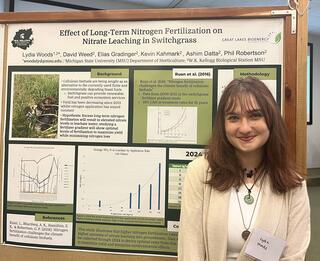Lydia Woods

In response to the current climate crisis, cellulosic biofuels are being sought as an alternative to the currently used finite and environmentally degrading fossil fuels. A potential alternative of interest is Switchgrass (Panicum virgatum), a perennial and native plant to Northern American prairies. In addition to being considered as a substitute for fossil fuels, Switchgrass could also replace corn grain ethanol as a fuel source, which would in turn reserve that grain for food purposes. Due to its perennial and native nature, Switchgrass can provide many benefits as a renewable fuel source, and also contribute to soil health and biodiversity. The focus of this study is how the sixteen-year-old crop responds to an applied nitrogen fertilizer gradient, specifically how the nitrogen application can be optimized in order to minimize climate change effects from excess nitrate leaching into groundwater or greenhouse gas emissions, while also maximizing yields and profitability. The gradient consists of a control group at 0 kg N /ha, then treatments of 28 kg N /ha, 56 kg N /ha, 84 kg N /ha, 112 kg N /ha, 140 kg N /ha, 168 kg N /ha, and 196 kg N /ha. The hypothesis is that long-term elevated N application in switchgrass would increase NO3- leaching and N2O emissions without yield benefits. Data has been collected through usage of lysimeters installed at a meter depth, static greenhouse gas chambers, greenseeker values, hydrosense values, plant heights, and soil inorganic carbon. The percolated water collected from the lysimeter was then analyzed using the Lachat or Ion Chromatograph. Results from this study were then compared to a previous study on the Nitrogen Gradient Switchgrass Field by Ruan et al. (2016) in order to discover the optimal rates for applied nitrogen as the plant ages, and to see if changes are present with excess application over time.